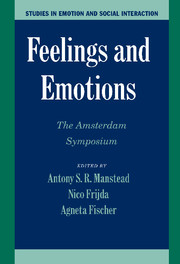Book contents
- Frontmatter
- Contents
- List of Contributors
- 1 Introduction
- PART I THE NATURE OF FEELINGS AND EMOTIONS
- PART II BASIC PSYCHOLOGICAL PROCESSES IN FEELINGS AND EMOTIONS
- 8 What We Become Emotional About
- 9 Feelings Integrate the Central Representation of Appraisal-driven Response Organization in Emotion
- 10 Emotions and Action
- 11 Basic Affects and the Instinctual Emotional Systems of the Brain
- 12 Exposure Effects
- 13 Feeling States in Emotion
- PART III FEELINGS AND EMOTIONS: THE PLACE OF PLEASURE
- PART IV FEELINGS AND EMOTIONS IN THEIR SOCIOCULTURAL CONTEXT
- PART V FEELINGS, EMOTIONS, AND MORALITY
- Subject Index
- Author Index
- Plate section
- References
13 - Feeling States in Emotion
Functional Imaging Evidence
Published online by Cambridge University Press: 05 June 2012
- Frontmatter
- Contents
- List of Contributors
- 1 Introduction
- PART I THE NATURE OF FEELINGS AND EMOTIONS
- PART II BASIC PSYCHOLOGICAL PROCESSES IN FEELINGS AND EMOTIONS
- 8 What We Become Emotional About
- 9 Feelings Integrate the Central Representation of Appraisal-driven Response Organization in Emotion
- 10 Emotions and Action
- 11 Basic Affects and the Instinctual Emotional Systems of the Brain
- 12 Exposure Effects
- 13 Feeling States in Emotion
- PART III FEELINGS AND EMOTIONS: THE PLACE OF PLEASURE
- PART IV FEELINGS AND EMOTIONS IN THEIR SOCIOCULTURAL CONTEXT
- PART V FEELINGS, EMOTIONS, AND MORALITY
- Subject Index
- Author Index
- Plate section
- References
Summary
ABSTRACT
An essential feature of emotional states is their association with change in autonomic function. The importance of these changes lies in the fact that in many theoretical accounts of emotion the realization of autonomic states is a primary means through which feeling states are realized. The issue addressed in this chapter is how the brain generates and represents autonomic states of the organism and their importance in feeling states. A distinction will be drawn between brain systems that mediate relatively automatic responses to emotional stimuli and systems that are involved in what can be termed conscious feeling states. These distinctions will be illustrated by observations from functional neuroimaging and patients with focal brain lesions and pathology of the autonomic nervous system.
Despite the impact of William James at the end of the nineteenth century, for the best part of several decades in the middle of the twentieth century, neuroscientists treated “emotion” and “feeling” as interchangeable terms. This approach to the language of emotion, coupled with the behaviorist movement prevalent in twentieth century psychology, meant that the neuroscientific study of emotion was grossly neglected, often seen as conceptually ragged and its practitioners as pursuing “soft science” (Damasio, 1999; Damasio, 1994; Damasio, 1998; LeDoux, 1996; LeDoux, 2000). Recent efforts, however, have put the study of emotion center stage in understanding the workings of the brain, proposing roles in cognition (Zajonc, 1980), decision making (Damasio, 1994), perception (Anderson & Phelps, 2001), and even consciousness (Panksepp, 1998; Damasio, 1999).
- Type
- Chapter
- Information
- Feelings and EmotionsThe Amsterdam Symposium, pp. 204 - 220Publisher: Cambridge University PressPrint publication year: 2004



